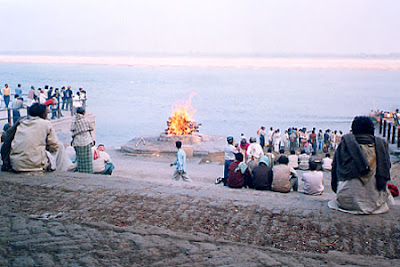 It might be a misconception that Tantrik cults are over and done with, for the essence of it still continues to prevail rather openly in West Bengal and Assam. While Kalighat and Tarapeeth might have been big centers for such practices the seat of ancient tantricism is at Kamakhya Devi temple, Kamarupa Assam. This is the most important of all the Shakti Peethas in India.
It might be a misconception that Tantrik cults are over and done with, for the essence of it still continues to prevail rather openly in West Bengal and Assam. While Kalighat and Tarapeeth might have been big centers for such practices the seat of ancient tantricism is at Kamakhya Devi temple, Kamarupa Assam. This is the most important of all the Shakti Peethas in India.Kamakhya devi shrine hosts the yoni of Sati that fell here following the destruction of Daksha's sacrifice. This Shakti Peetha symbolizes the union of Shiva with Shakti, as described in the Kali Purana. They are depicted in constant union where Kamakhya is the Goddess of desire, who grants salvation. She is the young bride of Lord Shiva and together they symbolize the sublime reality of the miracle of life, the everlasting bliss of male/female union. This temple is situated atop a hill that overlooks the Brahmaputra river. The inner sanctum is a deep dark underground rocky chamber into which one descends by a flight of steep steps. The "Matra Yoni" which is inscribed on a rock is covered with silk sarees and is constantly moist by underground spring water.
Tantrik cult is a different kind of cult where the orthodoxy of normal rituals and male dominance over the female took a massive beating. In tantricism, it’s the opposite where the female is given a lot more importance and is associated with Shakti. This is reflected in all their strange ritual practices. There is a deep divide between conventional worship and tantrik worship. In conventional worship, a woman is considered as "impure" during her 3 day monthly cycle, further to which she is almost treated as an untouchable in ancient brahmin traditions still prevailing today. In Tantrik worship, most of the rituals including initiation are centered on the 3 days, this period being the most important period where the woman is considered most pure and an incarnation of Shakti. This is clear from various references made in Tantric texts.
Most of the tantrik texts have been found around the regions of Kamarupa, suggesting very strong prevalence of this cult around the Kamakhya Devi temple. The Yoni Tantra hails from Cooch Bihar but most of the Kaul Tantras originated from Kamarupa. The earliest comprehensive references made to the most important element of Tantrik ritual, called Yoni Tattva in the Kaula Tantra are given in the Kaula Jnana Nirnaya by Matsyendranath.
A few references that really call for interest about this esoteric cult, and can be made mention of, are as follows.
1. The Shakti, represented here as Kamakhya Devi has close associations with the 64 Yoginis found elsewhere in Orissa. The yantra associated with Kamakhya devi empowers the 64 yoginis(Hirapur Chaunsat Yogini Temple, Khajuraho) as part of Shakti. The Tripura mantra "Aim Klim Sauh" represents the triple Kundalini. It is also believed that female sadhvikas who are well versed in Yoga dwell at Kamakhya peetha. If one joins them, they obtain yogini siddhi.
2. The Matrikas who dominated both Buddhist sculpture as well as Brahmanical, are the depiction of the importance of alphabet or sound in the worship of Shiva and Shakti. There are seven representations called the Sapta Matrikas, describing the importance of the alphabet in the Beeja mantra and associated hymns sung in the praise of Shiva and shakti.
3. This reference comes as an eye opener that Tantrik cults were not restricted to unknown tantriks who practiced in complete secrecy, but a few known faces also seem to be a part of this cult in thought.
With reference to Yoni tattva, Kaula tantras deal with the subject of menstrual blood as given in the following translation.
Matrikabheda Tantra (English translation Ideological Book House 1990) describes the different types:
"Shri Shankara said:
The first menses appearing in a woman who has lost her virginity is Svayambhu blood.
In a maiden born of a married woman and begotten by another man, that which arises is Kunda menses, the substance causing the granting of any desire.
Deveshi, a maiden begotten by a widow gives rise to Gola menses, which subdues gods.
The menses arising in the first period after a virgin becomes a married woman is the all bewildering Svapushpa."
Last but not the least is the dialog between the supreme creative power Brahma and Shakti. Brahma can create but only through the yoni which shall be the sole creative principle, and will bless the soul with life. After severe penance Brahma brought down a luminous body of light to earth and placed it within the yoni circle of Goddess Kamakhya at Kamarupa.

Courtesy: Translation (c) Lokanath Maharaj 1985. All rights reserved. Creativecommons.org





























